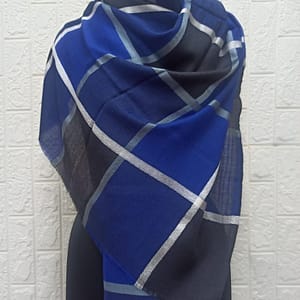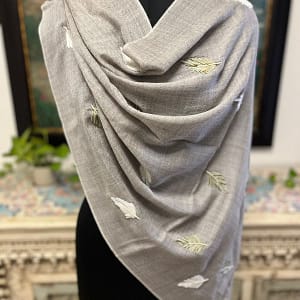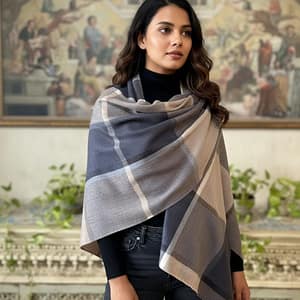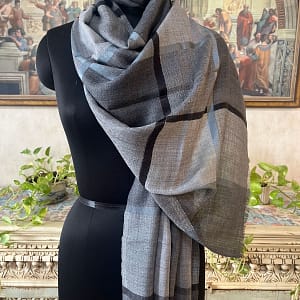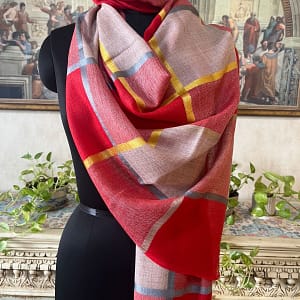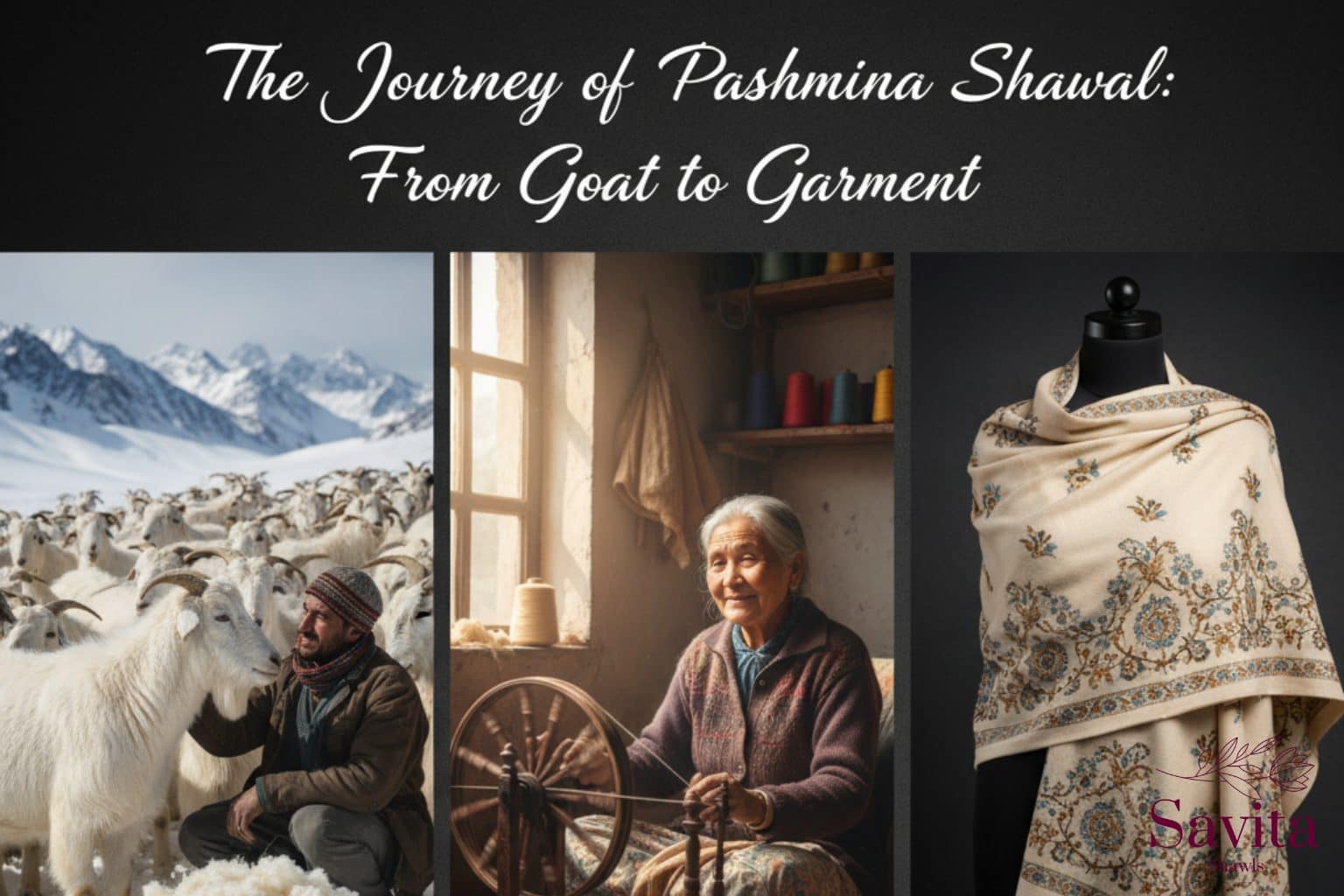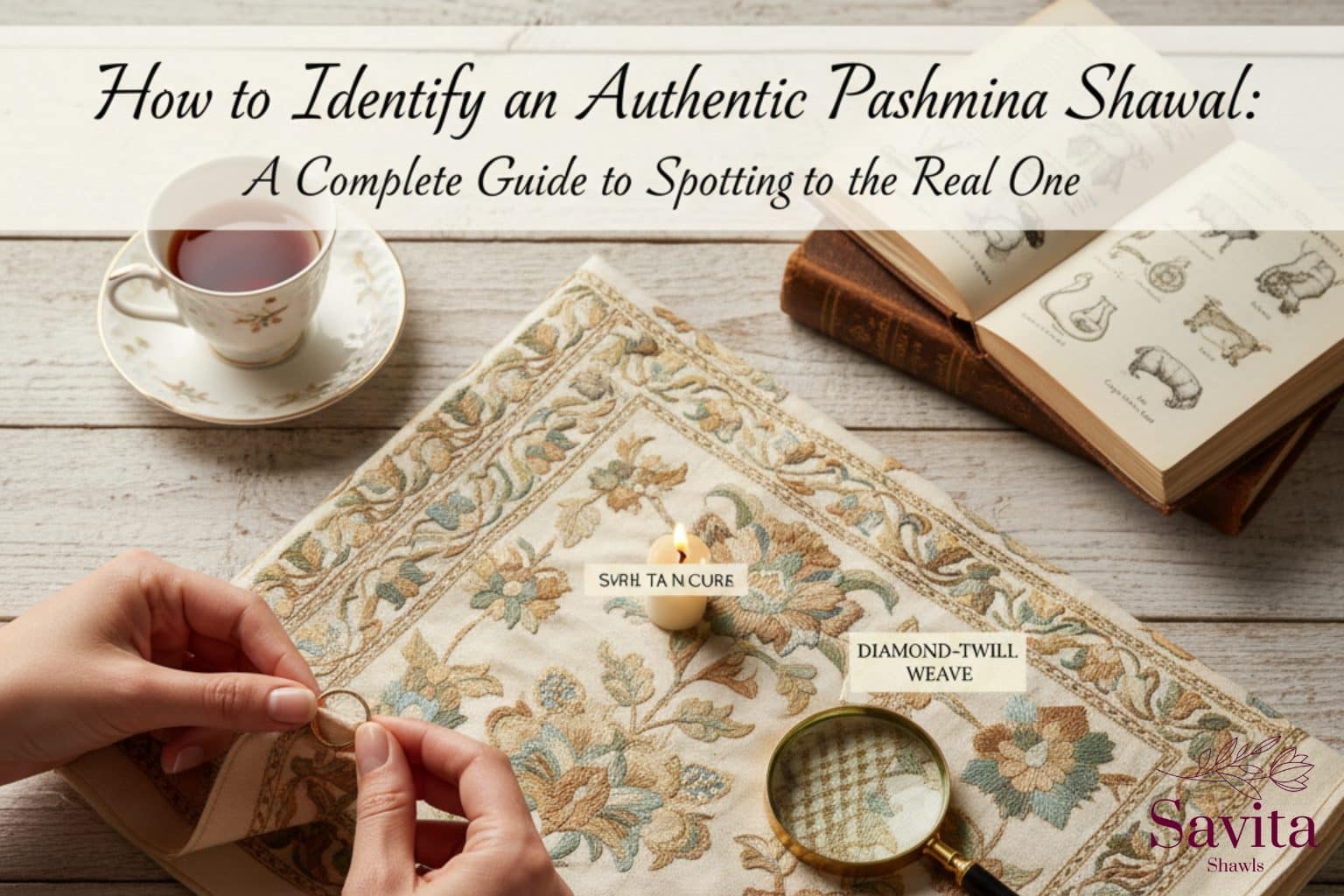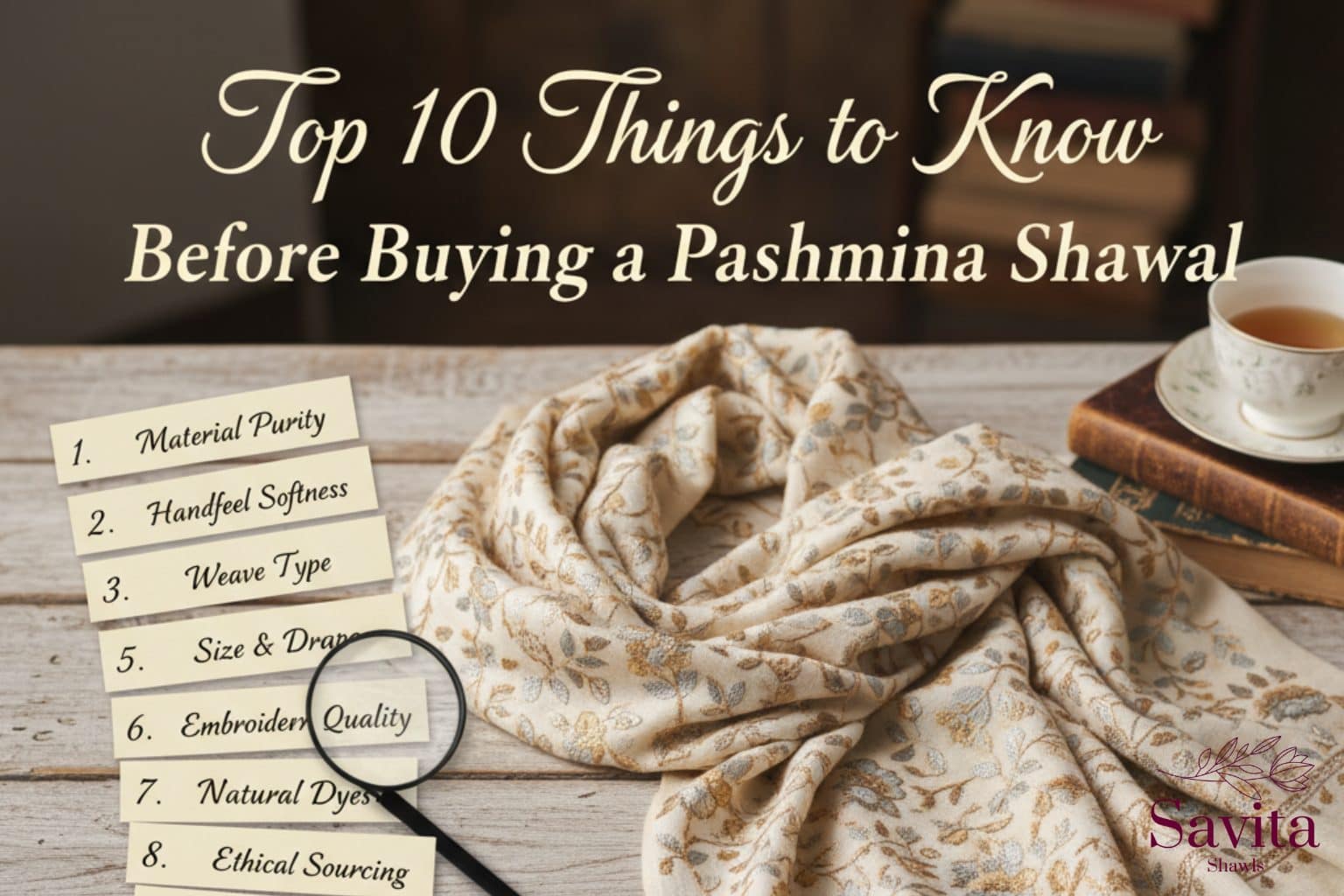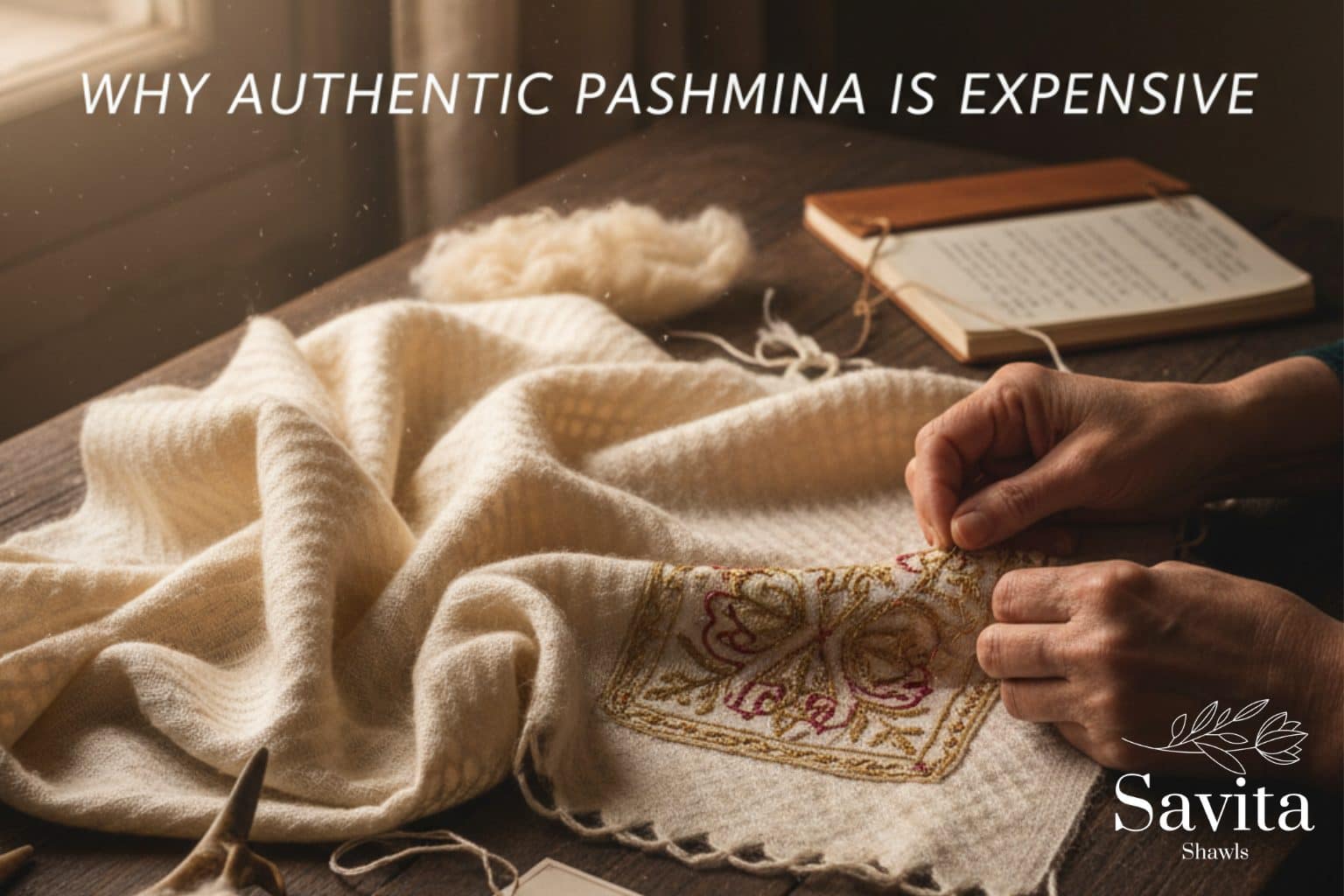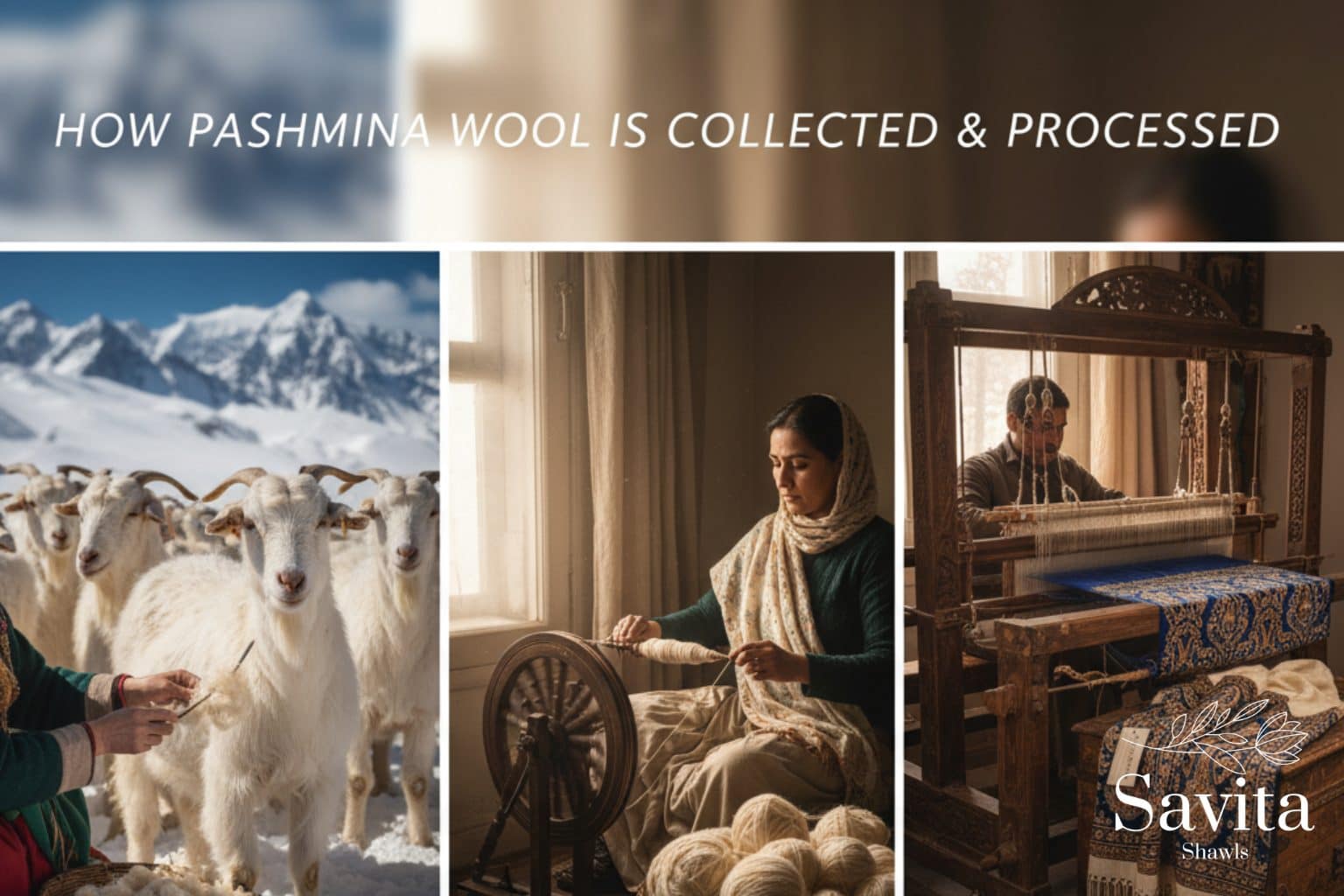Introduction: The Legacy of Pashmina
The origin of Pashmina is not about where a fabric began but is the beginning of an extraordinary journey that celebrates art, heritage, and timeless craftsmanship. Reputed as the “Soft Gold” of the Himalayas, the Pashmina from Kashmir is among the most luxurious and delicate fabrics ever created. Its charm lies in its story-a story woven from the snowy peaks of Ladakh down to the artistic hands of Kashmiri weavers who have kept this ancient tradition alive.
The Origin of Pashmina dates back several centuries, deeply rooted in the culture and lifestyle of Kashmir. Every piece of Pashmina from Kashmir carries not just beauty, but history — a legacy that has travelled through generations. The Origin of Pashmina tells us how this fine wool, once worn by kings and queens, became a global symbol of elegance and sophistication. More than just a textile, Pashmina Shawls is an emotion, an heirloom, and a connection to the land it comes from.
1. Born in the Lap of the Himalayas
The origin of Pashmina begins high in the Himalayan ranges of Ladakh, home to the rare Changthangi goats. These goats produce an exceptionally fine undercoat of wool to survive freezing temperatures. This wool is the raw form of Pashmina — soft, warm, and incredibly light. From the harsh climate of Ladakh to the artistic valleys of Kashmir, this journey marks the true Kashmiri Pashmina Heritage. The care, patience, and respect given to every fibre reflect the purity and spirit of its Himalayan birthplace.
2. The Art of Hand Weaving
The Origin of Pashmina is closely related to the history of Kashmir craftsmanship. All processes are manually operated from the beginning to the end — the whole process of hand weaving is what characteristically Pashmina of Kashmir. The artisans take weeks or even months to create a single shawl using centuries-old techniques. Their expertise in dealing with fragile Fibres and turning them into stunning pieces retains the Pashmina of Kashmir Heritage getting into every weft.
3. A Legacy of Kashmiri Artistry
While discussing the Pashmina’s Origin, we naturally also mention the people who are the very source of it — the Kashmirian skilled workers. Their love, quality of mind, and devotion are the very things that breathe into every single unit. The whole of Kashmiri Pashmina Heritage is resting on their craftsmanship, from plain weaves to very intricate embroidery like Sozni, Tilla and Kani. These patterns that have been around for centuries capture the essence of every Pashmina from Kashmir being a unique object — one that carries the signature of the region’s rich cultural and artistic heritage.
4. From Local Craft to Global Luxury
Kashmir was the birthplace of Pashmina and its History has expanded beyond the region over the centuries. The soft and India and Persia used to wear Pashmina from Kashmir as a global luxury that was also admired in Europe and the Middle East. Its unmatched quality, softness, and warmth made it one of the most sought-after fabrics in the world. Today, the Origin of Pashmina is still the source of inspiration for fashion designers, collectors, and connoisseurs who appreciate originality and tradition.
At Savita Shawls, we are proud to uphold the Kashmiri Pashmina Legacy. It is handwoven by craftsman who carry forward the Origin of Pashmina in their work. When you wrap yourself in a Pashmina, it’s not just a shawl — it is embracing a living piece of history that links Kashmir’s age-old craftsmanship with the contemporary world.
Early Beginnings in the Himalayas
The story of Pashmina goes far back into the mystical Himalayas where nature had been functioning through the medium of art and the whole thing came then to the surface as Tradition. The whole incident now dates back to the high-altitude region of Ladakh where the wildlife bestowed the place with the rare and endangered Changthangi goats that somehow even managed to live in the coldest spots on the globe. Living at more than 14,000 feet, these goats are subjected to the worst weather conditions and freezing winds and they get to produce a very fine and soft under-coat that is quite a big help in their survival and they are called very low by the human world of Pashm, one day the finest and most precious fabric of the world — Pashmina from Kashmir will be made out of it.
The Origin of Pashmina goes along this remarkable natural adaptation. The residents of Ladakh after the observation of making better and warmer jackets out of the wool lately began to collect, spin by hand, and dye it before making the wool. What was by chance a small effort to keep warm gradually became art. The locals quickly recognised that the short strand could make shawls that were lighter, softer, and warmer than any other fabric known to mankind.
With the expanding trade routes, the fiber traveling from Ladakh through Kashmir’s valleys found its way into the skilled hands of Kashmiri artisans. This moment marked a new era in Pashmina’s history — the meeting of the very finest raw material of nature and the peak of human skill. In Kashmir the artisans have turned the unrefined Pashm into splendid shawls through the old hand-weaving techniques. Hence the Kashmir Pashmina Heritage was created — the ideal combination of Himalayan purity and Kashmiri artistry that still sets the standard of luxury.
The term “Pashmina” originated from the Persian term “Pashm,” which translates to “soft gold.” This expression not only highlights the worthiness but also the core qualities of the fiber—the things that are rare, warm, and dear. The story of Pashmina is not only about it as a fiber but as a robust symbol of human and nature’s relationship through the testing of time.
1. The Birthplace: Ladakh’s Frozen Highlands
Pashmina’s origin has been linked back to the icy desolate land of Ladakh, which is the habitat of the Changthangi goat, where the finest wool in the world is produced that can be pulled through a tiny ring without breaking. This miraculous event of nature gave a new birth to Kashmir—the global icon of elegance—Pashmina. The goats of the Himalayas are still, as ever, the spirit of Pashmina Heritage, the Kashmiri Pashmina, representing purity and sustainability in each and every thread.
2. The Transformation: From Fibre to Fabric
In the very early days of history concerning Pashmina, the villagers of Ladakh used to collect Pashm during the spring shedding season. They would then manually spin and weave it into simple but warm fabrics. Eventually, the wool would go to Kashmir where it would be transformed into art. What was once dark and dirty was turned by the Kashmiri craftsmen into soft shawls, this was done through the use of various weaving methods that were intricate. The development of this technology became the attraction of the Kashmiri Pashmina, appreciated through the world for its detail and warmth.
3. The Art Meets Culture
The Origin of Pashmina evolved and became united with the very culture of Kashmir over the centuries. This craft was an emblem of indulged, sophisticated, and artistic pride. Kashmir Pashmina was presented as royal gifts to kings and lords, and the trade route was open to travelers who acknowledged and appreciated beauty and charm. Each piece bore the imprint of Kashmir’s artisanship, showing the perseverance and love that characterize the Origin of Pashmina even now.
4. A Legacy That Endures
The simple practice of gathering wool in the Himalayas has its origin turned into a heritage and style icon worldwide. The Origin of Pashmina is still a motivation for both the artisans and the fashion lovers. The whole process — from the Changthangi goats of Ladakh to the skilled weavers of Kashmir — is the very definition of sustainable luxury. Savita Shawls pays tribute to this tradition and celebrates Pashmina Heritage among the pieces that are made.
How Pashmina Reached Kashmir
The Origin of Pashmina would have been a secret limited to the Himalayas if Ladakh’s trade and cultural exchanges with the picturesque valley of Kashmir had not been the reason for its coming out. In the 14th century, traders who moved through the Silk Route brought the soft Pashm wool from the highlands of Ladakh into the fertile valleys of Kashmir. This marked the start of a new era — when the raw natural beauty of the Himalayan wool met the artistic genius of Kashmiri craftsmanship.
The Origin of Pashmina tells that it was Mir Syed Ali Hamdani, a highly regarded Persian scholar and saint, who initially took this craft down the road of art. He went to Kashmir along with a group of skilled Persian weavers who brought with them new spinning and weaving methods. They not only taught the local craftsmen to work with the fine Pashm fibres but also led them to produce the delicate, luxurious fabric now called Pashmina from Kashmir.
Kashmir’s winter season, diverse culture, and stunning nature combined to create a perfect home for the delicate craft. Here, the Pashmina Origin found its artistic spirit. The Kashmir weavers were very skilled at the process and operated with yarn that was hand-spun only on traditional wooden looms to produce incredibly soft and graceful fabrics. Not just a talent but a lifestyle, it became the identity, and the base of the Kashmiri Pashmina Heritage which is still alive today.
1. The Cultural Bridge Between Persia and Kashmir
The Pashmina story has been intertwined with the cultural link that existed between Persia and Kashmir. The coming of Persian craftsman to the valley not only introduced new design tastes but also brought along new weaving patterns. The combined forces of their mastery and that of the Kashmiri weavers resulted in a unique art form — the Kashmiri Pashmina Heritage. The shawls were made so thin that one could pass a finger ring through them but they were still very warm and soft; they also had very fine and elaborate designs, thus, they were admired for their grace and beauty.
The Origin of Pashmina thus came to be not only a wool-changing process but a truly cultural exchange that brought art, faith, and tradition together.
2. The Growth of Artistry in Kashmir
The moment the Pashmina from Kashmir became known worldwide, the local craftsmen became the best in the entire process. They acquired the skills needed to clean, spin and weave the fine thread by hand trolling with great perseverance. The Origin of Pashmina was frankly expanded over generations as the techniques were handed down from master to apprentice, keeping the authenticity intact.
Every creative thought of Kashmiri artisans was reflected in the weaves, and they made astonishing patterns such as Kani, Sozni, and Tilla. The embroidery methods, in turn, made the shawls deeper, more significant, and more individual. Every piece had the potential to become more than a mere garment – it was an artistic creation that symbolized the Kashmiri Pashmina Heritage and the spiritual Source of Pashmina that started in the Himalayan highlands.
3. The Symbol of Royalty and Prestige
Initially, Pashmina from Kashmir became a coveted item in the royal courts of India, Persia, and later the whole of Europe. The shawls were gems among kings, nobles, and aristocrats — tokens of respect, beauty, and elegance. They were the part of the royal wardrobe and were frequently presented as symbols of honor during diplomatic meetings.
The Origin of Pashmina thus got sealed with the luxury and prestige. Each piece that was handwoven was an image of grace, patience, and passion — the very nature of Kashmir’s cultural spirit. Even now, gifting a Pashmina is a symbol of warmth and everlasting love, thus making it a perfect choice for weddings, festivals, and heirloom keepsakes.
4. The Legacy That Lives On
Long ago, the story of Pashmina’s revocation continued to inspire every conceivable non-Indian and fashion house all over the world. The tale of Pashmina from Kashmir is a story of the strong — a craft that weathered the changes of time but kept its originality intact. The Kashmir Pashmina Heritage, even now, holds its head high as it is woven into the lives of families of weavers, who, dedicating themselves completely to this art, uphold the tradition.
At Savita Shawls, we are so proud to carry the torch of this heritage that we have kept the Origin of Pashmina alive by staying true to the traditional way of making shawls. The shawl that we make will be the same as the one that was made years ago in Ladakh, came to Kashmir, and then all over the world as a classic symbol of elegance that never fades.
The Role of Kashmiri Artisans
The origin of Pashmina can only be comprehended adequately and beautifully through the hands of the artisans from Kashmir who make it — the artisans of Kashmir. The skilled weavers have for centuries been the very heart and soul of the Kashmiri Pashmina Heritage, converting the fine Pashm wool from the Himalayas into stunning shawls that have been appreciated and criticized everywhere in the world. Their skill is not only an emblem of craftsmanship but a continuous tradition that links modern fashion to ancient heritage and vice versa.
Artisans from Srinagar valley to Pampore and Ganderbal villages have been working for ages to create Kashmiri Pashmina of the highest quality. Their work is a demonstration of patience, precision, and pride — characteristics that apply not only to the shawls but also to the weavers themselves. Each thread they spin, each pattern they weave, and each stitch they embroider is a narrative — the narrative of the Origin of Pashmina and the eternal beauty it holds.
1. The Spirit of Handmade Perfection
The history of WPashmina can be traced back to the gradual rhythm of spinning wheels and the creaking sound of wooden looms. Even at the present time, the manufacturing process is entirely handmade. In the rural areas of the Pashmina-producing regions, women are still spinning the delicate Pashmina yarn on traditional charkhas and making sure that every strand is soft and strong. At the same time, men are working with handlooms and weaving the threads into beautiful patterns that show both their skills and hearts.
This whole labor-intensive process makes the Pashmina from Kashmir quite different from other textiles. A shawl can take weeks or months to make—that’s how much effort and creativity go into it. The process also helps the Kashmiri Pashmina Heritage to be passed on continually and to keep the centuries-old traditional knowledge that originated with Pashmina in the Himalayas.
2. The Art Beyond Weaving — Embroidery and Detailing
The weaving of the shawl marks the end of the process, after which, many shawls receive the gift of hand embroidery, which in turn, makes them more elegant. The delicately done Sozni, well-known for its Tilla of gold and also Aari embroidery in attractive colors are the prominent forms of such embroidery being done under the Pashmina of Kashmir. This is very intricate work that needs great patience and accuracy, usually done by craftsmen who have got this art from their ancestors.
The Origin of Pashmina is replete with anecdotes of spinners and dyers who devoted their entire lives to mastering these embroidery styles. Each pattern is culturally significant—floral designs, paradises, being influenced by Mughal gardens, paisleys that stand for fertility and infinity, and geometric shapes mirroring Kashmiri architecture. Combining weaving and embroidery gives the talent of Kashmiri Pashmina Heritage that unmatched artistic identity.
3. Preserving a Timeless Heritage
During the course of history, the artisans of Kashmir have encountered various difficulties — including civil disturbances and the rise of machine-made replicas. Nevertheless, their loyalty remained. They still keep the Origin of Pashmina with the utmost tenderness and dedication, just as their forefathers did hundreds of years ago. Numerous households in Kashmir have been engaged in the Pashmina weaving process for a long time and not only they pass on a profession but also a sacred legacy.
The weavers’ resistance guarantees that every handmade shawl embodies the Origin of Pashmina. These artists are the living protectors of the Kashmiri Pashmina Heritage, the authenticity and the emotional depth being preserved by them in an ever more commercial world. Carrying a genuine Pashmina from Kashmir means owning a piece of their spirit — a masterwork of nature and human commitment fused together.
4. The Human Connection: More Than Just a Craft
To the fabric makers, Pashmina is more than a material — it is a feeling, a societal position, and a source of income. The hands of the artisans don’t only weave; they love, they create. The Origin of Pashmina is not only a tale of a fibre but also a tale of a community that has supported this art for over 600 years.
Savita Shawls takes a pledge to promote this dedication by engaging in direct collaboration with the artisans who are the custodians of the Kashmiri Pashmina Heritage. Each shawl from our collection glorifies the Origin of Pashmina and the incredible individuals who make it possible — the real artists imbedded in every timeless masterpiece.
Pashmina in Royal Courts and Global Trade
The Origin of Pashmina is one of the most astonishing narratives in the realm of culture and the fashion world. The story of Pashmina has traveled through time in a very luxurious and artistic way from the snow-covered valleys of Kashmir to the splendid courts of emperors and queens, thus, speaking of the grace that is timeless.
The Royal Love for Pashmina from Kashmir
Pashmina from Kashmir was highly appreciated during the Mughal period. Emperor Akbar, who had an impeccable taste for beauties, was quite mesmerized by the unrivaled softness and warmth of the Kashmiri Pashmina Heritage shawls. He would lavishly use them as gifts to royalty and ceremonial offerings. The shawls created by skilled Kashmiri craftsmen resonated with the traits of nobility and refinement, hence, making it clear the strong bond between arts, traditions, and prestige.
In fact, the value of these shawls was so great that the Mughal court had certain classifications for them according to fabric quality and weaving excellence—their site being a tribute to the high regard of Pashmina in India’s royal history.
Pashmina’s Journey to Europe and Beyond
The 18th and 19th centuries were a turning point for the Origin of Pashmina. With the help of the traditional trade routes, Pashmina from Kashmir started coming to Europe through the Silk Road. The French and English aristocrats were quick to admire the elegant texture and artistic designs of these shawls.
In France, Kashmiri Pashmina Heritage was a fashion among aristocrats and noblewomen. Emperor Napoleon was famous for sending Pashmina shawls from Kashmir to Empress Josephine, thus, raising their royal status even more. The delicate weaving and fine craftsmanship made these shawls a hot commodity thus, turning Pashmina’s Origin into a universal sign of sophistication.
The Symbol of Luxury and Global Admiration
Over time, Pashmina from Kashmir became not just a textile but an art form that was accepted all over the world. The European fashion houses took inspiration from its beauty and introduced Pashmina-inspired patterns in haute couture. The Victoria and Albert Museum in London and the Musée du Louvre in Paris are some of the museums that have kept antique Pashmina pieces and thus display the deep Origin of Pashmina and its artistic influence.
The Kashmiri Pashmina Heritage is therefore a link between cultures — a story that has been woven with threads of royalty, trade, and craftsmanship. The Origin of Pashmina still attracts global admirers, thereby turning every shawl into a timeless heirloom that joins past grandeur with present luxury.
Modern Revival of Traditional Weaving
The fabric of Pashmina has its very roots in the mastery of the hands and the pride of the heritage. But then, the fakes made by machines slowly took over the market and the Pashmina’s allure got rather less an attraction due to this. Nevertheless, a century down the line, there is now a full-fledged revival – the hard to miss such a movement to eradicate the fakes and preserve the authentic artistry of the wonderful Pashmina from Kashmir.
Renewed Respect for Handcrafted Luxury
The true origin of Pashmina is being rediscovered by the modern consumers, fashion designers, and the global brands. The people are becoming more conscious about what really gives the Pashmina from Kashmir its distinctive and alluring characteristics—its fineness, heat retention, and the personal involvement of the weaver in every single strand woven. The people’s consciousness in this matter has brought the Pashmina Heritage of Kashmir back to its original glory and branding, persuading the consumers to go for shawls which are handmade, eco-friendly, and ethically sourced, rather than mass produced ones.
Organizations, government agencies, and heritage brands such as Savita Shawls are maintaining this over one thousand year legacy, toiling hard for the same. They are working in close partnership with the artisans to secure fair pay, technical sourcing of raw Pashmina wool, and the application of the traditional weaving techniques that are in line with the authentic History of Pashmina.
Blending Tradition with Modern Design
The new generation of Kashmiri artisans is giving the Origin of Pashmina a modern twist while staying faithful to its roots. By introducing contemporary designs, softer colour palettes, and lightweight weaves, they are ensuring that Pashmina from Kashmir remains relevant in today’s global fashion landscape. Whether it’s a classic stole or a modern wrap, every piece still carries the heart of the Kashmiri Pashmina Heritage — a story of patience, creativity, and devotion.
These innovations help Pashmina appeal to younger audiences who seek both style and meaning. By merging centuries-old weaving traditions with modern aesthetics, artisans are crafting pieces that are not only fashionable but also deeply symbolic of the History of Pashmina.
A Global Movement for Preservation
This revival goes far beyond fashion — it represents a global respect for cultural sustainability. The Origin of Pashmina is being celebrated across international platforms, with exhibitions, workshops, and designer collaborations showcasing the unparalleled charm of Pashmina from Kashmir. Each shawl is now seen not just as an accessory but as a heritage statement that connects the past, present, and future.
The revival of the Kashmiri Pashmina Heritage is a story of resilience. It honours the artisans who continue to weave by hand, preserving the same traditions passed down through generations. It reminds the world that the History of Pashmina is not a tale of the past — it’s a living legacy, kept alive through passion, skill, and pride.
Savita Shawls: Preserving Pashmina Heritage
Savita Shawls is a company that upholds the supreme quality and beauty of Pashmina, the most luxurious and elegant material of all time. In fact, our trail is woven right into the Pashmina Heritage of Kashmir, where every single thread reveals the story of its creator’s love, culture, and exceptional skill. We take the Pashmina of Kashmir not as a mere textile but as a vibrant tradition that binds the purity of the Himalayas to the centre of exquisite craftsmanship.
Authentic Wool, Genuine Origins
We start with the very root, namely, the icy peaks of Ladakh where the unusual Changthangi goats produce the softest wool, which is the world’s softest. This organic fibre, also known as “Pashm,” is the very heart of every piece we create. By using only the genuine wool, we make sure that every item shows the true Origin of Pashmina. Each shawl contains the heat of the mountains, and the process of blending and weaving has been done with the utmost precision to keep the purity that is characteristic of the History of Pashmina.
At Savita Shawls, we regard authenticity as the be-all and end-all. The quality that we maintain through our rigorous checks makes sure that every piece of Pashmina from Kashmir is completely hand-woven, dyed or coloured by natural means only, and worked on by those who observe the decades-old methods of the craft with reverence.
Handcrafted by Master Artisans of Kashmir
The importance of the Pashmina Heritage of Kashmir is in its skilful workers who spin it. Our Kashmiri craftsmen practise the old charkhas and wooden looms in making every shawl—an operation that may last for weeks or even months. Whether it is a delicate Kani weave, elaborate Zari borders, or hand embroidery that whispers of royal grace, every piece is not only a celebration of the History of Pashmina but also that of the commitment of the masters who keep this craft alive.
Each artisan’s proficiency is a consequence of tradition passed down through several generations. They do not only weave but also infuse it with feelings—changing the ordinary wool into something that would be cherished throughout the years as a sign of love, patience, and grace. At Savita Shawls, we are very proud to be the connecting link between the ancient Origin of Pashmina and present-day luxury lovers who appreciate timelessness.
A Mission Beyond Fashion
Our purpose is not only to produce beautiful shawls but also to keep a cultural identity alive. We support local communities and fair-trade practices, which allow the History of Pashmina to be written by the artisans empowered and the nature-friendly practices adopted. Every piece purchased from Savita Shawls plays a part in protecting the Kashmiri Pashmina Heritage, which will enable traditional craftsmanship to survive and even thrive for the coming generations.
We pair the purity of ancient ways with modern design aesthetics, thus marrying the past with the future. The vivid pastel shades of today as well as the classic designs are among the factors that make our Pashmina from Kashmir collection a perfect blend of style and story.
Celebrating the Global Journey of Pashmina
Pashmina’s magic from Kashmir has not only captivated the world but also Savita Shawls who faithfully offer the company’s authenticity and cultural value. Each shawl we produce carries with it the rich History of Pashmina—from the snow-capped mountains of Ladakh through the artistic heart of Kashmir to finally reaching the fans worldwide.
The Origin of Pashmina is not only our inspiration but our promise too – to keep this great heritage in its purest form and to spread it all over the world. With our collections, we give you the chance to feel the unequaled charm and warmth of the real Kashmiri Pashmina Heritage.
Conclusion: The Timeless Beauty of Pashmina
The Origin of Pashmina is not just a part of history but rather it is a living story told with passion, art, and cultural pride. The History of Pashmina from the snowy mountains of Ladakh to the royal courts of India and then to the rest of the world is showing us the way of mankind’s creativity and nature’s bounty.
Even now, Kashmir’s Pashmina is still the best and the most luxurious, graceful, and skillfully made symbol. When you decide to buy the real Pashmina, you are not just choosing elegance but also helping the Pashmina Heritage and the craftsmen who dedicate their whole life to this art that never fades away.
We at Savita Shawls are carrying on this legacy — one handcrafted masterpiece at a time.
Related Products
Showing 1–6 of 805 results
-
Savita Shawls Royal Blue & Black Wool Natural Silk Box Pashmina Shawl for Women
Read more -
Savita Shawls Elegant Grey & Black Wool Natural Silk Box Pashmina Shawl for Women
Read more -
Beige & Charcoal Wool Natural Silk Box Design Pashmina Shawl for Women
Read more -
Yellow & Navy Wool Natural Silk Box Design Pashmina Shawl for Women
Read more -
Grey & Black Wool Natural Silk Box Design Pashmina Shawl for Women
Read more -
Red & Beige Wool Natural Silk Box Design Pashmina Shawl for Women
Read more


